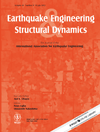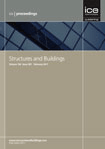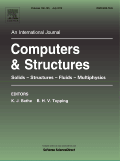
STRUCTURAL SAFETY
Scope & Guideline
Empowering engineers with cutting-edge insights.
Introduction
Aims and Scopes
- Probabilistic Reliability Analysis:
Research on probabilistic methods for assessing the reliability of structures under various loads and conditions, including advanced techniques like Bayesian inference and Monte Carlo simulations. - Uncertainty Quantification:
Studies that focus on quantifying uncertainties in structural parameters and environmental conditions, employing methods such as stochastic modeling and sensitivity analysis. - Life-Cycle Assessment and Management:
Exploration of life-cycle approaches to structural reliability, including the impacts of maintenance, deterioration, and environmental factors on structural performance. - Seismic and Extreme Event Resilience:
Research on the resilience of structures to seismic activities and other extreme events, including the development of fragility curves and risk assessment methodologies. - Innovative Structural Design Techniques:
Advancements in design methodologies that incorporate reliability principles, including adaptive learning and optimization techniques for improved structural performance. - Multi-Hazard Risk Assessment:
Studies addressing the performance of structures under multiple hazards, integrating various environmental factors such as wind, earthquakes, and floods.
Trending and Emerging
- Bayesian Inference and Machine Learning:
An increasing trend in the application of Bayesian methods and machine learning techniques for model updating, reliability assessment, and uncertainty quantification. - Adaptive and Real-Time Monitoring Systems:
Emerging research focuses on the integration of real-time monitoring systems for structural health assessment, utilizing data-driven approaches to enhance reliability analysis. - Climate Change Impact Assessments:
Growing interest in understanding the effects of climate change on structural performance and reliability, leading to innovative methodologies for adapting designs to changing environmental conditions. - Advanced Stochastic Modeling Techniques:
There is a trend towards employing advanced stochastic models for analyzing uncertainties in structural behavior, including non-Gaussian processes and spatial variability. - Multi-Scale and Multi-Fidelity Approaches:
Emerging methodologies that combine multi-scale modeling and multi-fidelity analyses are gaining traction, allowing for more efficient reliability assessments across complex systems. - Integration of Human Factors in Structural Safety:
A rising focus on the influence of human and organizational factors on structural safety, indicating a broader understanding of risks associated with structural systems.
Declining or Waning
- Traditional Deterministic Approaches:
There has been a noticeable decrease in research focused on traditional deterministic methods for structural analysis, as probabilistic and stochastic approaches gain prominence. - Basic Structural Analysis Techniques:
Basic methods of structural analysis, which do not incorporate uncertainty or risk assessments, are becoming less common in favor of more complex, reliability-based analyses. - Static Load Analysis:
Research specifically centered on static load analysis of structures has diminished, possibly due to the increasing recognition of dynamic and environmental load impacts. - Simplistic Design Codes:
Simplistic adherence to outdated design codes without considering modern risks and uncertainties is waning as researchers advocate for more robust, risk-informed design practices. - Single-Hazard Focus:
Research that focuses on the impact of a single hazard type is declining, as there is a growing trend toward multi-hazard assessments that consider various concurrent risks.
Similar Journals

International Journal of Structural Integrity
Connecting Academia and Industry through Structural Integrity ResearchInternational Journal of Structural Integrity is a premier peer-reviewed academic journal published by EMERALD GROUP PUBLISHING LTD in the United Kingdom. As a valuable resource in the fields of Civil and Structural Engineering, Mechanical Engineering, and Mechanics of Materials, this journal serves to advance knowledge and foster innovation in these critical areas of study. With an impressive impact factor reflected in its 2023 category quartiles, ranking Q2 across multiple engineering disciplines, the journal is recognized for its contributions to research and practical application. Researchers can benefit from its rigorous publishing standards that encompass a wide array of interdisciplinary topics pertaining to structural integrity. Accessing the journal is facilitated for those seeking high-quality research and findings, vital to both academia and industry. Since its inception in 2010 and extending until 2024, the journal continues to attract scholarly articles that push the boundaries of engineering knowledge, making it an essential platform for professionals, students, and researchers seeking to stay at the forefront of structural engineering."

Journal of Structural Fire Engineering
Elevating standards in fire safety and engineering.The Journal of Structural Fire Engineering is a premier academic publication dedicated to advancing the field of fire safety and structural engineering. Published by Emerald Group Publishing Ltd, this journal features high-quality research and innovative solutions addressing crucial aspects of safety, risk, reliability, and the mechanics of materials. With an impact factor that reflects its growing influence in the academic community and a classification in the Q3 quartile across several engineering categories, the journal plays a vital role in disseminating knowledge that bridges theoretical concepts and practical applications. With coverage spanning from 2010 to 2024, researchers, professionals, and students can access a wealth of studies that explore the intersection of structural integrity and fire safety. While it currently operates under a subscription model, the journal remains committed to sharing pivotal insights that drive forward the discipline. Join the community of experts striving to enhance engineering practices and resilience against fire-related hazards.

Structure and Infrastructure Engineering
Advancing the Future of Engineering ExcellenceStructure and Infrastructure Engineering, published by TAYLOR & FRANCIS LTD, is a premier academic journal that serves as a vital resource in the fields of engineering and construction. Featuring an ISSN of 1573-2479 and an E-ISSN of 1744-8980, this journal has established its reputation as a leader in disseminating high-quality research. Since its inception, it has successfully transitioned through converged years from 2007 to 2024, earning a prestigious position within the Q1 quartile across multiple engineering disciplines, including Building and Construction, Civil and Structural Engineering, and Ocean Engineering, among others. Its impact is underscored by impressive Scopus rankings, particularly its 5th rank in Ocean Engineering within the top 95th percentile. The journal’s commitment to advancing knowledge in safety, risk, reliability, and quality makes it an indispensable platform for researchers, professionals, and students aiming to stay at the forefront of engineering innovations. Access to its comprehensive articles allows for a deeper understanding of contemporary challenges and solutions in infrastructure development.

EARTHQUAKE ENGINEERING & STRUCTURAL DYNAMICS
Connecting research and practice for safer structures.EARTHQUAKE ENGINEERING & STRUCTURAL DYNAMICS, published by Wiley, is a leading journal recognized for its significant contributions to the domains of civil and structural engineering, as well as geotechnical engineering and engineering geology. With an impressive Q1 ranking in multiple categories, including Civil and Structural Engineering, and an esteemed Scopus ranking placing it in the 82nd percentile, the journal serves as a premier platform for disseminating pioneering research and innovative methodologies related to earthquake engineering and dynamic structural analysis. Established in 1972, this journal boasts a comprehensive coverage of topics from theoretical developments to practical applications, making it an essential resource for researchers, industry professionals, and students eager to expand their understanding of seismic safety and structural resilience. Though it does not offer open access, the journal continues to be a cornerstone for scholarly communication within the earthquake engineering community, advancing knowledge that shapes better engineering practices worldwide.

Bulletin of the New Zealand Society for Earthquake Engineering
Advancing earthquake resilience through innovative research.Bulletin of the New Zealand Society for Earthquake Engineering (ISSN: 1174-9857, E-ISSN: 2324-1543) is a leading scholarly journal published by the New Zealand Society for Earthquake Engineering, Inc., dedicated to advancing the field of earthquake engineering. Since its inception in 1970, the journal has provided a vital platform for the dissemination of innovative research, technical studies, and case reports related to civil and structural engineering, as well as geotechnical engineering and engineering geology. Recognized for its significant contributions, the journal holds a Q2 ranking in both the Civil and Structural Engineering and Geotechnical Engineering and Engineering Geology categories as of 2023. It serves as an invaluable resource for researchers, professionals, and students keen on enhancing their understanding of earthquake resilience and engineering practices. While the journal operates under subscription-based access, its rigorous peer-review process ensures that published articles meet the highest academic standards, making it a credible source for the global engineering community.

PROCEEDINGS OF THE INSTITUTION OF CIVIL ENGINEERS-STRUCTURES AND BUILDINGS
Exploring the Frontiers of Structural EngineeringPROCEEDINGS OF THE INSTITUTION OF CIVIL ENGINEERS-STRUCTURES AND BUILDINGS, published by Emerald Group Publishing Ltd, is a leading journal in the fields of Building and Construction and Civil and Structural Engineering. Since its inception in 1992, this journal has served as a vital platform for disseminating high-quality research and innovative practices within the industry, contributing to the advancement of engineering knowledge and its applications. With an impact factor reflective of its significant presence in the field, this publication ranks in the Q3 category, reinforcing its role as an essential resource for researchers and professionals alike, positioning it among the top journals in its category. As of 2023, it holds notable Scopus rankings, emphasizing its credibility and influence within both Building and Construction (Rank #88/223) and Civil and Structural Engineering (Rank #171/379). Researchers aiming to enhance their understanding of cutting-edge developments in civil engineering will find this journal indispensable in accessing a wealth of knowledge, methodologies, and case studies that shape the infrastructures of tomorrow.

Bulletin of Earthquake Engineering
Transforming knowledge into seismic resilience.The Bulletin of Earthquake Engineering is a premier journal published by Springer, dedicated to the field of earthquake engineering and its related disciplines. Established in 2003, this esteemed journal has evolved into a critical platform for disseminating cutting-edge research in Building and Construction, Civil and Structural Engineering, Geophysics, and Geotechnical Engineering and Engineering Geology, earning a distinguished position in the Q1 quartile across these categories. With an impressive ranking in Scopus, notably a rank of #8 in Earth and Planetary Sciences for Geophysics, the journal addresses urgent challenges in the mitigation of seismic risks and the enhancement of structural resilience. Researchers and practitioners benefit from a wealth of peer-reviewed articles, insights, and methodologies relevant to modern engineering practices aimed at improving safety and sustainability in earthquake-prone regions. The Bulletin of Earthquake Engineering embodies a commitment to advancing knowledge and practice in earthquake resilience, making it an invaluable resource for academics, industry professionals, and rising scholars alike.

Ingegneria Sismica
Pioneering knowledge in geotechnical engineering and seismic resilience.Ingegneria Sismica, a premier journal published by PATRON EDITORE S R L, serves as an essential platform for the dissemination of research in the fields of building and construction, geotechnical engineering, and safety risk management. With a focus on earthquake engineering and structural safety, the journal has established itself as a prominent source of knowledge since its inception in 2010. The journal holds an impressive Q2 classification in multiple categories, including Building and Construction and Geotechnical Engineering, reflecting its significant impact within these disciplines. Despite its Italian roots, it appeals to an international audience of researchers, professionals, and students dedicated to advancing the understanding of seismic resilience and risk mitigation strategies. Although open access is not currently available, the potential for knowledge sharing and innovative methodologies presented in the articles continues to attract a robust readership. With its commitment to excellence and relevance, Ingegneria Sismica is poised to shape future discourse in engineering practices aimed at enhancing safety, reliability, and quality within seismic zones.

Structures
Building Knowledge for a Resilient TomorrowStructures is a premier interdisciplinary journal published by Elsevier Science Inc, dedicated to advancing the fields of architecture, building and construction, civil and structural engineering, and safety, risk, reliability, and quality. With its ISSN 2352-0124, this scholarly journal showcases cutting-edge research and innovative practices that drive the evolution of structural design and analysis. Since its establishment in 2015, Structures has swiftly garnered high esteem, achieving a Q1 ranking in four key categories as of 2023, and placing within the top percentiles in various engineering disciplines, making it an essential resource for industry professionals, researchers, and students alike. The journal promotes a comprehensive understanding of contemporary challenges and solutions within its scope, providing a platform for disseminating impactful research. Access options may vary, but the commitment to high-quality, peer-reviewed content remains a constant in fostering academic growth and industry advancement.

COMPUTERS & STRUCTURES
Integrating Technology with Structural ExcellenceCOMPUTERS & STRUCTURES is a leading interdisciplinary journal published by Pergamon-Elsevier Science Ltd, focusing on the application of computer methods in the fields of civil and structural engineering, mechanical engineering, materials science, and modeling and simulation. With a prestigious history dating back to its inception in 1971, this journal is committed to advancing the knowledge and methodologies that integrate computational techniques with structural analysis and design. Recognized in 2023 with a Q1 ranking across several categories, including Civil and Structural Engineering and Computer Science Applications, COMPUTERS & STRUCTURES emphasizes the importance of innovative research that pushes the boundaries of traditional engineering practices. Although the journal does not currently offer open access, it remains an invaluable resource for researchers, professionals, and students seeking to disseminate and discuss groundbreaking findings that are shaping the future of engineering and materials science. The rigorous peer-review process ensures the publication of high-quality articles that contribute to the global discourse in these critical fields.